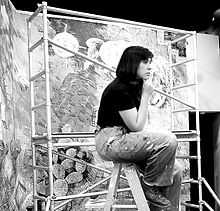Judithe Hernández


In 1965, Hernández became the first student to win the "Future Masters Scholarship" (awarded at LACMA and funded by the Sears & Roebuck Foundation and the Los Angeles Chamber of Commerce) which enabled her to attend Otis Art Institute in Los Angeles. In 1972, after earning a B.F.A. at Otis, she began graduate studies there. When Carlos Almaraz enrolled in the graduate program that year, it marked the beginning of a long friendship and professional association as members of Los Four. Along with Almaraz, she became involved in the Chicano civil-rights movement and worked on such projects as the Chicano Moratorium Against the War. During her time at Otis, Hernández studied drawing with the renowned artist Charles White. White, an African-American artist had spent time in Mexico, and was an admirer of indigenous and Latin American art. In 1971, while working as the illustrator of the Aztlán Journal, published by the UCLA Chicano Studies Research Center, Hernández illustrated the first volume of poetry by the celebrated Mexican-American poet Alurista, Floricanto en Aztlán. In 2013, the 40th anniversary edition of Floricanto received three prizes at the International Latino Book awards.
After earning her M.F.A.'s at Otis, she and Almaraz collaborated with El Teatro Campesino, worked on behalf of the United Farm Workers, and as members of the Concilio de Arte Popular (CAP), they worked to create an organization that united Chicano artists across the state of California. Chicano arts organizations such as the Royal Chicano Air Force of Sacramento; Galeria de la Raza, in San Francisco, and the artists of Chicano Park in San Diego were among those who during the 1970s participated in CAP.[2] In 1981, she and seven other Chicano muralists painted murals inside the Craft and Folk Art Museum in Los Angeles for an exhibition entitled The Murals of Aztlán. She and the other artists were criticized in Artweek by reviewer Shifra Goldman for "shedding ... their cultural identity and political militance" in order to "enter the mainstream as competitive professionals." Hernández responded "why should changes in my work and socio-political attitudes be construed as compromising my commitment ... while in another artist the same would be construed as personal and professional growth?"[3]
Hernández lived in Chicago for 25 years and before her to return to Los Angeles, she was honored by the National Museum of Mexican Art with her last solo exhibition in Chicago. La Vida Sobre Papel, opened in January 2011 and included several new series of work, one of which was the noted serial murders of women in Ciudad Juárez. According to the Chicago Weekly, "The only thing as conspicuous as the artist’s skill is her message: being human is hard, a woman harder, and life as a Latina occasionally downright grisly."[4]
In 2011, Hernández was among a select group of artists whose contributions to the art of Los Angeles were honored in multiple exhibitions which were part of the sweeping arts initiative known as "Pacific Standard Time: Art of Los Angeles 1945–1980" (PST), funded by the Getty Foundation and the Getty Research Institute. In 2012, Hernández was selected as a recipient of the prestigious C.O.L.A. Fellowship (City of Los Angeles Individual Artist Fellowship) for 2013. She was also selected by the Metropolitan Transportation Authority of Los Angeles for the coveted EXPO LINE Terminus Station commission at Colorado & 4th Street in Santa Monica. The "Downtown Santa Monica" station which is scheduled to open in 2016, is currently under construction. When completed, the station will feature 24 works by Hernández positioned over its two platforms and a sculpture installation at the plaza level by architect Walter Hood.
In 2013, Hernández is one of 72 artists chosen for the first major exhibition of Latino art by contemporary American artists of Latino descent at the Smithsonian American Art Museum. "Our America: The Latino Presence in American Art will open in October 2013. All the works in the exhibition are part of the Smithsonian's permanent collection and will tour various museums around the U.S. beginning in 2014.
Hernández currently serves on the Board of Directors of the Mural Conservancy of Los Angeles, the Arts & Letters Council of the Mexican Museum, San Francisco, and is the Chair of the Otis College of Art & Design Alumni Council.
References
- ↑ 1.0 1.1 LaTorre, Guisela (2008). Walls of Empowerment: Chicano/a Indigenist Murals of California. Austin: University of Texas Press. ISBN 978-0-292-71883-8. Available on Google Books. Retrieved August 13, 2011.
- ↑ 2.0 2.1 "Oral history interview with Judithe Hernández, 1998 Mar. 28, Archives of American Art, Smithsonian Institution". Retrieved August 13, 2011.
- ↑ Lomelí, Francisco, ed. (1993). Handbook of Hispanic cultures in the United States, Volume 3: Literature and Art. Arté Publico Press, University of Houston. ISBN 1-55885-074-0. Available on Google Books. Retrieved August 13, 2011.
- ↑ Riehle, Christopher (February 9, 2011). "Pain on Paper". Chicago Weekly. "(available online)". Retrieved August 13, 2011.
Solo Exhibitions
- Mi Arte, Mi Raza — Los Angeles Municipal Art Gallery, 1978.
- Virgen, Madre, Mujer: Imágenes de la Mujer Chicana – Casa de la Raza, Santa Barbara, CA 1979.
- A Decade of a Woman's Work – Solart Gallery, San Diego, CA 1980.
- Judithe Hernández: Works on Paper – Cayman Gallery, New York, NY 1983.
- What Dreams May Come / Qué Sueños Quizás Vengan – Woman Made Gallery, Chicago, IL 2010.
- La Vida Sobre Papel – National Museum of Mexican Art, Chicago, IL 2011.
Public Art Commission
- EXPO Line Downtown Santa Monica Terminus Station, Santa Monica, CA - Opens 2016
Fellowships
- City of Los Angeles Individual Artist Fellowship, 2013
Artist in Residence
- University of Chicago, Center for the Study of Race, Politics, and Culture, 2011
External links
- "Our America: The Latino Presence in American Art". Retrieved August 19, 2013.
- "C.O.L.A. Fellowship Online Catalog". Retrieved August 19, 2013.
- "Judithe Hernández Official Website". Retrieved August 13, 2011.
- "Pacific Standard Time: Art in Los Angeles 1945–1980". Retrieved September 11, 2011.